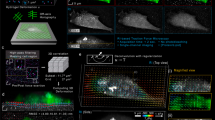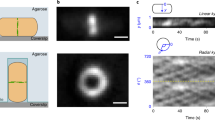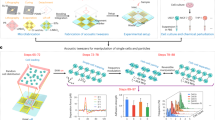Abstract
The mechanical stability and deformability of the cell nucleus are crucial to many biological processes, including migration, proliferation and polarization. In vivo, the cell nucleus is frequently subjected to deformation on a variety of length and time scales, but current techniques for studying nuclear mechanics do not provide access to subnuclear deformation in live functioning cells. Here we introduce arrays of vertical nanopillars as a new method for the in situ study of nuclear deformability and the mechanical coupling between the cell membrane and the nucleus in live cells. Our measurements show that nanopillar-induced nuclear deformation is determined by nuclear stiffness, as well as opposing effects from actin and intermediate filaments. Furthermore, the depth, width and curvature of nuclear deformation can be controlled by varying the geometry of the nanopillar array. Overall, vertical nanopillar arrays constitute a novel approach for non-invasive, subcellular perturbation of nuclear mechanics and mechanotransduction in live cells.
This is a preview of subscription content, access via your institution
Access options
Subscribe to this journal
Receive 12 print issues and online access
$259.00 per year
only $21.58 per issue
Buy this article
- Purchase on Springer Link
- Instant access to full article PDF
Prices may be subject to local taxes which are calculated during checkout






Similar content being viewed by others
References
Caille, N., Thoumine, O., Tardy, Y. & Meister, J-J. Contribution of the nucleus to the mechanical properties of endothelial cells. J. Biomech. 35, 177–187 (2002).
Khatau, S. B. et al. The distinct roles of the nucleus and nucleus–cytoskeleton connections in three-dimensional cell migration. Sci. Rep. 2, 488 (2012).
Lee, J. S. H. et al. Nuclear lamin A/C deficiency induces defects in cell mechanics, polarization, and migration. Biophys. J. 93, 2542–2552 (2007).
Roca-Cusachs, P. et al. Micropatterning of single endothelial cell shape reveals a tight coupling between nuclear volume in G1 and proliferation. Biophys. J. 94, 4984–4995 (2008).
Jain, N., Iyer, K. V., Kumar, A. & Shivashankar, G. V. Cell geometric constraints induce modular gene-expression patterns via redistribution of HDAC3 regulated by actomyosin contractility. Proc. Natl Acad. Sci. USA 110, 11349–11354 (2013).
Taylor, M. R. et al. Natural history of dilated cardiomyopathy due to lamin A/C gene mutations. J. Am. Coll. Cardiol. 41, 771–780 (2003).
Méjat, A. et al. Lamin A/C-mediated neuromuscular junction defects in Emery–Dreifuss muscular dystrophy. J. Cell Biol. 184, 31–44 (2009).
Rowat, A. C., Lammerding, J. & Ipsen, J. H. Mechanical properties of the cell nucleus and the effect of emerin deficiency. Biophys. J. 91, 4649–4664 (2006).
Lammerding, J. et al. Abnormal nuclear shape and impaired mechanotransduction in emerin-deficient cells. J. Cell Biol. 170, 781–791 (2005).
Hale, C. M. et al. Dysfunctional connections between the nucleus and the actin and microtubule networks in laminopathic models. Biophys. J. 95, 5462–5475 (2008).
Goldman, R. D. et al. Accumulation of mutant lamin A causes progressive changes in nuclear architecture in Hutchinson–Gilford progeria syndrome. Proc. Natl Acad. Sci. USA 101, 8963–8968 (2004).
Yang, S. H. et al. Eliminating the synthesis of mature lamin A reduces disease phenotypes in mice carrying a Hutchinson–Gilford progeria syndrome allele. J. Biol. Chem. 283, 7094–7099 (2008).
Ivanovska, I., Swift, J., Harada, T., Pajerowski, J. D. & Discher, D. E. Physical plasticity of the nucleus and its manipulation. Methods Cell Biol. 98, 207–220 (2010).
Guilak, F., Tedrow, J. R. & Burgkart, R. Viscoelastic properties of the cell nucleus. Biochem. Biophys. Res. Commun. 269, 781–786 (2000).
Dahl, K. N., Engler, A. J., Pajerowski, J. D. & Discher, D. E. Power-law rheology of isolated nuclei with deformation mapping of nuclear substructures. Biophys. J. 89, 2855–2864 (2005).
Lombardi, M. L. & Lammerding, J. Altered mechanical properties of the nucleus in disease. Methods Cell Biol. 98, 121–141 (2010).
Lammerding, J. & Lee, R. T. Mechanical properties of interphase nuclei probed by cellular strain application. Methods Mol. Biol. 464, 13–26 (2009).
Davidson, P. M., Özçelik, H., Hasirci, V., Reiter, G. & Anselme, K. Microstructured surfaces cause severe but non-detrimental deformation of the cell nucleus. Adv. Mater. 21, 3586–3590 (2009).
Badique, F. et al. Directing nuclear deformation on micropillared surfaces by substrate geometry and cytoskeleton organization. Biomaterials 34, 2991–3001 (2013).
Pan, Z. et al. Control of cell nucleus shapes via micropillar patterns. Biomaterials 33, 1730–1735 (2012).
Versaevel, M., Grevesse, T. & Gabriele, S. Spatial coordination between cell and nuclear shape within micropatterned endothelial cells. Nature Commun. 3, 671 (2012).
Fu, Y., Chin, L. K., Bourouina, T., Liu, A. Q. & VanDongen, A. M. J. Nuclear deformation during breast cancer cell transmigration. Lab Chip 12, 3774–3778 (2012).
Wolf, K. & Friedl, P. Mapping proteolytic cancer cell–extracellular matrix interfaces. Clin. Exp. Metastasis 26, 289–298 (2009).
Fidziañska, A., Walczak, E., Glinka, Z. & Religa, G. Nuclear architecture remodelling in cardiomyocytes with lamin A deficiency. Folia Neuropathologica 46, 196–203 (2008).
Kim, W., Ng, J. K., Kunitake, M. E., Conklin, B. R. & Yang, P. Interfacing silicon nanowires with mammalian cells. J. Am. Chem. Soc. 129, 7228–7229 (2007).
Hanson, L., Lin, Z. C., Xie, C., Cui, Y. & Cui, B. Characterization of the cell–nanopillar interface by transmission electron microscopy. Nano Lett. 12, 5815–5820 (2012).
Bucaro, M. A., Vasquez, Y., Hatton, B. D. & Aizenberg, J. Fine-tuning the degree of stem cell polarization and alignment on ordered arrays of high-aspect-ratio nanopillars. ACS Nano 6, 6222–6230 (2012).
Shalek, A. K. et al. Vertical silicon nanowires as a universal platform for delivering biomolecules into living cells. Proc. Natl Acad. Sci. USA 107, 1870–1875 (2010).
Curtis, A. S. G., Dalby, M. J. & Gadegaard, N. Nanoprinting onto cells. J. R. Soc. Interface 3, 393–398 (2006).
Xie, C., Lin, Z., Hanson, L., Cui, Y. & Cui, B. Intracellular recording of action potentials by nanopillar electroporation. Nature Nanotech. 7, 185–190 (2012).
Robinson, J. T. et al. Vertical nanowire electrode arrays as a scalable platform for intracellular interfacing to neuronal circuits. Nature Nanotech. 7, 180–184 (2012).
Xie, C., Hanson, L., Cui, Y. & Cui, B. Vertical nanopillars for highly localized fluorescence imaging. Proc. Natl Acad. Sci. USA 108, 3894–3899 (2011).
Ostlund, C. et al. Dynamics and molecular interactions of linker of nucleoskeleton and cytoskeleton (LINC) complex proteins. J. Cell Sci. 122, 4099–4108 (2009).
Huang, B., Wang, W., Bates, M. & Zhuang, X. Three-dimensional super-resolution imaging by stochastic optical reconstruction microscopy. Science 319, 810–813 (2008).
Swift, J. et al. Nuclear lamin-A scales with tissue stiffness and enhances matrix-directed differentiation. Science 341, 1240104 (2013).
McClintock, D., Gordon, L. B. & Djabali, K. Hutchinson–Gilford progeria mutant lamin A primarily targets human vascular cells as detected by an anti-lamin A G608G antibody. Proc. Natl Acad. Sci. USA 103, 2154–2159 (2006).
Eriksson, M. et al. Recurrent de novo point mutations in lamin A cause Hutchinson–Gilford progeria syndrome. Nature 423, 293–298 (2003).
De Sandre-Giovannoli, A. et al. Lamin A truncation in Hutchinson–Gilford progeria. Science 300, 2055 (2003).
Cao, H. & Hegele, R. A. LMNA is mutated in Hutchinson–Gilford progeria (MIM 176670) but not in Wiedemann–Rautenstrauch progeroid syndrome (MIM 264090). J. Hum. Genet. 48, 271–274 (2003).
Dahl, K. N. et al. Distinct structural and mechanical properties of the nuclear lamina in Hutchinson–Gilford progeria syndrome. Proc. Natl Acad. Sci. USA 103, 10271–10276 (2006).
Booth-Gauthier, E. A. et al. Hutchinson–Gilford progeria syndrome alters nuclear shape and reduces cell motility in three dimensional model substrates. Integr. Biol. 5, 569–577 (2013).
Claycomb, W. C. et al. HL-1 cells: a cardiac muscle cell line that contracts and retains phenotypic characteristics of the adult cardiomyocyte. Proc. Natl Acad. Sci. USA 95, 2979–2984 (1998).
Geiger, B., Spatz, J. P. & Bershadsky, A. D. Environmental sensing through focal adhesions. Nature Rev. Mol. Cell Biol. 10, 21–33 (2009).
Khatau, S. B. et al. A perinuclear actin cap regulates nuclear shape. Proc. Natl Acad. Sci. USA 106, 19017–19022 (2009).
Stamenović, D., Mijailovich, S. M., Tolić-Nørrelykke, I. M., Chen, J. & Wang, N. Cell prestress. II. Contribution of microtubules. Am. J. Physiol. Cell Physiol. 282, C617–C624 (2002).
Maniotis, A. J., Chen, C. S. & Ingber, D. E. Demonstration of mechanical connections between integrins, cytoskeletal filaments, and nucleoplasm that stabilize nuclear structure. Proc. Natl Acad. Sci. USA 94, 849–854 (1997).
Ingber, D. E. Tensegrity I. Cell structure and hierarchical systems biology. J. Cell Sci. 116, 1157–1173 (2003).
Wang, N. & Stamenovic, D. Contribution of intermediate filaments to cell stiffness, stiffening, and growth. Am. J. Physiol. Cell Physiol. 279, C188–C194 (2000).
Vaziri, A., Lee, H. & Mofrad, M. R. K. Deformation of the cell nucleus under indentation: mechanics and mechanisms. J. Mater. Res. 21, 2126–2135 (2006).
Kim, D-H. et al. Actin cap associated focal adhesions and their distinct role in cellular mechanosensing. Sci. Rep. 2, 555 (2012).
Acknowledgements
This work was supported by the National Science Foundation (award no. 1055112 and 1344302), the National Institutes of Health (grant no. DP2NS082125), a Searle Scholar award, a Packard Science and Engineering Fellowship (to B.C.) and a National Defense Science and Engineering Graduate Fellowship (to Z.L.). The authors thank H. Worman at Columbia University for providing the GFP-Sun2 plasmid. The authors thank M. Lin at Stanford University for helping with the confocol microscope.
Author information
Authors and Affiliations
Contributions
L.H., B.C. and Y.C. designed experiments. L.H., W.Z., H.L. and Z.L. carried out the experiments. L.H. and S.W.L. designed and carried out the simulations. L.H. and P.C. designed and carried out the data analysis. All authors contributed to scientific planning, discussions and writing of the manuscript.
Corresponding authors
Ethics declarations
Competing interests
The authors declare no competing financial interests.
Supplementary information
Supplementary information
Supplementary information (PDF 1746 kb)
Supplementary information
Supplementary Movie 1 (AVI 324 kb)
Supplementary information
Supplementary Movie 2 (AVI 140 kb)
Supplementary information
Supplementary Movie 3 (AVI 2818 kb)
Supplementary information
Supplementary Movie 4 (AVI 508 kb)
Rights and permissions
About this article
Cite this article
Hanson, L., Zhao, W., Lou, HY. et al. Vertical nanopillars for in situ probing of nuclear mechanics in adherent cells. Nature Nanotech 10, 554–562 (2015). https://doi.org/10.1038/nnano.2015.88
Received:
Accepted:
Published:
Issue Date:
DOI: https://doi.org/10.1038/nnano.2015.88
This article is cited by
-
Nanotopographic micro-nano forces finely tune the conformation of macrophage mechanosensitive membrane protein integrin β2 to manipulate inflammatory responses
Nano Research (2023)
-
Chromatin reprogramming and bone regeneration in vitro and in vivo via the microtopography-induced constriction of cell nuclei
Nature Biomedical Engineering (2023)
-
Membrane curvature regulates the spatial distribution of bulky glycoproteins
Nature Communications (2022)
-
Biointerface design for vertical nanoprobes
Nature Reviews Materials (2022)
-
Titania nanospikes activate macrophage phagocytosis by ligand-independent contact stimulation
Scientific Reports (2022)



